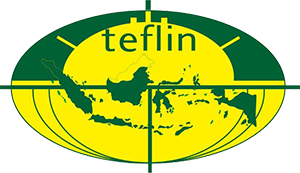I Don't Understand What They Speak: Photovoice of Indonesian Higher Education Students
Abstract
Keywords
Full Text:
PDFReferences
Arya, V., & Medgyes, P. (2000). Native and non-native teachers in the classroom. Sytem, 28, 355-372.
Becke, S. D., & Bongard, S. (2018). Using photo elicitation to introduce a network perspective on attachment during middle childhood. International Journal of Qualitative Methods, 17(1), Article 1609406918797017.
Behrendt, M., & Machtmes, K. (2016). Photovoice as an evaluation tool for student learning on a field trip. Research in science & technological Education, 34(2), 187-203.
Brannstrom, K. J., Rudner, M., Carlie, J., Sahlén, B., Gulz, A., Andersson, K., & Johansson, R. (2021). Listening effort and fatigue in native and non-native primary school children. Journal of Experimental Child Psychology, 210, 105203. https://doi.org/10.1016/j.jecp.2021.105203
Ciolan, L., & Manasia, L. (2017a). Reframing Photovoice to Boost Its Potential for Learning Research. International Journal of Qualitative Methods, 16(1). https://doi.org/10.1177/1609406917702909
Ciolan, L., & Manasia, L. (2017b). Reframing Photovoice to Boost Its Potential for Learning Research. International Journal of Qualitative Methods, 16(1), 1–15. https://doi.org/10.1177/1609406917702909
Esterberg, K.G. (2002). Qualitative methods in social research. Boston: McGraw-Hill.
Glaser, B.G., & Strauss, A.L. (1967). The discovery of grounded theory: Strategies for qualitative research. New York: Aldine De Gruyter.
Ha, S.S., & Whittaker, A. (2016). Closer to my world : Children with autism spectrum disorder tell their stories through photovoice, 546-563. https://doi.org/10.1080/116572117441692
Horii, S., Pham, H. T. T., Dang, T. T. N., Nguyen, C. T. M., & Amaike, N. (2021). Nurses’ perception of individual and organizational changes caused by a novel clinical training system for new graduate nurses: A qualitative research using photovoice. Nurse Education Today, 102, 104901. https://doi.org/10.1016/j.nedt.2021.104901
Kotla, B., Bosman, L. B., & Keller, J. (2021). How photovoice can be used for continuous improvement within an aviation certified flight academic degree program. International Journal of Educational Research Open, 2–2(December 2020), 100042. https://doi.org/10.1016/j.ijedro.2021.100042
Kelly, K., Lee, S. H., Bowen Ray, H., & Kandaurova, M. (2018). Using the photovoice methodology to increase engagement and sharpen students’ analytical skills regarding cultures, lifestyles, and markets internationally. Marketing Education Review, 28(2), 69-74.
Latz, A.O., & Mulvihill, T.M. (2017). Photovoice reserach in education and beyond: A practical guide from theory to exhibition. New York: Routledge.
Long, M. H. (1983). Linguistic and Conversational Adjustments to Non-Native Speakers. Studies in Second Language Acquisition, 5(2), 177–193. https://doi.org/10.1017/S0272263100004848
McGarrigle, R., Rakusen, L., & Mattys, S. (2021). Effortful listening under the microscope: Examining relations between pupillometric and subjective markers of effort and tiredness from listening. Psychophysiology, 58(1). https://doi.org/10.1111/psyp.13703
Murray. N. (2011). Ten ‘good practice principles’ Ten key questions: considerations in addressing the English language needs of higher education students, 233-246 https://doi.org/10.1080/55538907294360
Ronzi, S., Pope, D., Orton, L., & Bruce, N. (2016). Using photovoice methods to explore older people's perceptions of respect and social inclusion in cities. SSM-Population Health. 16(2), 732-745. https://doi.org/10.1016/j.ssmph.2016.09004
Saldana, J. (2009). The coding manual for qualitative researchers. Los Angeles: Sage.
Vargas, C. M. Walker, M., & Mkwananzi, F. (2019). Access to higher education in South Africa 427-442. https://doi.org/10.1080/161276709650792
Wass, R., Anderson, V., Rabello, R., Golding, C., Rangi, A., & Eteuati, E. (2019). Photovoice research methods for higher education research, 834-850, as a https://doi.org/10.1080/169279107294360
Xu, Z. (2018). Exploring English as an international language curriculum, materials and pedagogical strategies, https://doi.org/10.1177/0033688217753848
DOI: http://dx.doi.org/10.21043/jetli.v4i2.11946
Refbacks
- There are currently no refbacks.
Copyright (c) 2021 Journal of English Teaching and Learning Issues







